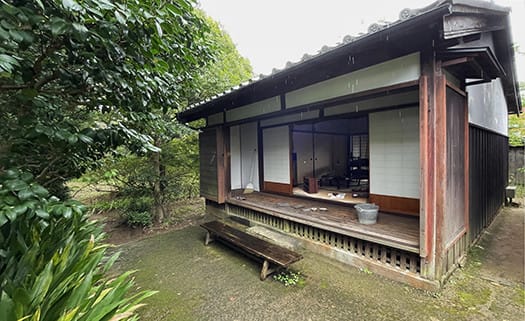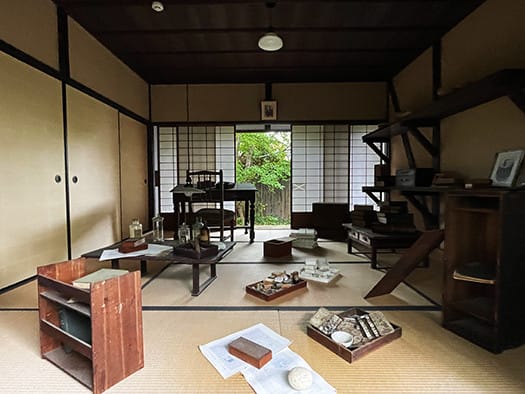


写真は、南方熊楠邸のなかの「書斎」周辺の様子。わたしが南紀に強く惹かれるようになったのは、記紀伝承での神武東征譚にどのような空間的な「蓋然性根拠」があるのだろうか、という探究心からでした。そこから難波から迂回して神武帝の一統がふたたび上陸したとされる楯ヶ崎を実際に足で踏破してみた。
まさか、そういう神話的なポイントが「観光地化」されていないとは夢にも思わず、ほんの5−6台程度の駐車場から、実際に楯が海にそそり立っているような楯ヶ崎の柱状節理地形を見て驚かされた。
太古の巨大火山噴火によるカルデラ地形が太平洋の黒潮による浸食を受け続けた南紀の風土地形を見て、北海道の層雲峡と同等以上の「自然崇拝」を呼ぶに違いない荒々しさに心を奪われてしまったのです。そういった荒々しい地形と皇統神話が歴年にわたる天皇家による平安期の「熊野参詣」を生起させていった事情も、ひとつの日本史の「地学的」断面として納得感が湧き上がっていった。北海道ネイティブ人間からすると、北海道の大自然とも通底するような「自然」パワーを感じさせられていた。
そこにはアマテラス、イザナミなどの神話に蓋然性を与えるようなパワーがあった。独特の熊野信仰の基底にそういった部分を色濃く感じさせられたのですね。そういった「自然崇拝」こそが日本の「国生み」譚とも結びついた側面を見せられた次第。
今回参観している南方熊楠さんの自邸、その経歴のなかで特筆すべきは、昭和天皇が深くかれの自然探求に共鳴されて、戦艦・長門に乗船されてこの地におもむき、南方熊楠はこの南紀の植生について「ご進講」したということ。昭和帝はながく植物研究されていたことで知られていますが、その基礎には南方熊楠の研究へのリスペクトがあったのだと思います。さらに南方熊楠は、明治期の政府が全国の神社を統廃合しようとしたのに対して、怖れることなく反対の声を上げた人物としても知られる。かれは全国の神社空間が日本の国土の自然保全にとっていかに重要な空間であるかを怖れることなく言挙げした。昭和帝はそういった流れを踏まえてなお、南方熊楠にリスペクトされていた事実。
このような近現代史のひとつの大きな側面のなかで南紀の風土が、なにがしか大きな背景を構成していることに気付かされたのです。

日本の中央政権はこのような南紀・熊野の自然からその山並みを越えた大和平野から始原する。そしてアマテラスのような自然崇拝、さらに興味深いスサノオという人物譚を始原神話として持っている。そういった背景からやはり南紀の風土性についてより深く知りたくなった。旅は永く続きそうです(笑)。
English version⬇
Amaterasu “Nature Worship” and the Climate of Nanki, Kumagusu Minakata Residence-5
The huge caldera topography of Nanki-Kumano has an important geological aspect in the creation tale of this country. The Kuroshio Current has been crashing wildly into this landform. ...
The photo shows the area around the “study” in the residence of Minakata Kumagusu. I became strongly attracted to the Nanki region because of my curiosity about what kind of spatial “probability basis” there was for the tale of the Jimmu expedition in the Chronicles of the Chronicles. From there, I detoured from Namba and actually stepped on foot to Tategasaki, where the line of the Emperor Jinmu is said to have landed once again.
I had never dreamed that such a mythical point had not been “turned into a tourist spot,” and was surprised to see the columnar-jointed topography of Tategasaki from a parking lot with only five or six cars, where a shield actually seems to tower over the sea.
Seeing the endemic topography of Nanki, where the caldera topography caused by a huge volcanic eruption in ancient times has been continuously eroded by the Kuroshio Current of the Pacific Ocean, I was fascinated by the ruggedness that must call for “nature worship” equal to or greater than that of Sounkyo in Hokkaido. The fact that such rugged terrain and the myth of the imperial lineage gave rise to the “Kumano Pilgrimage” by the emperors over the years during the Heian period (794-1185) also made sense to me as a “geological” cross section of Japanese history. As a native of Hokkaido, I was made to feel the power of “nature” that is commonly associated with the great nature of Hokkaido.
There was a power that gave probability to the myths of Amaterasu and Izanami. You were made to feel such aspects strongly at the base of the unique Kumano faith. Such “nature worship” is also connected to the Japanese tale of the “birth of the nation”.
It should be noted that Emperor Showa deeply sympathized with Minakata Kumagusu's nature study, and he boarded the battleship Nagato to visit this place, where Minakata Kumagusu gave him a lecture on the vegetation of this Nanki area. The Showa Emperor is known to have been a botanical researcher for a long time, and I believe that his respect for the research of Minakata Kumagusu was the foundation of his research. Furthermore, Minakata Kumagusu is also known as a person who voiced his opposition to the Meiji government's attempt to consolidate shrines throughout Japan, without fear. He was unafraid to speak out about the importance of shrine spaces throughout Japan for the preservation of the country's natural environment. The Showa Emperor still respected Minakata Kumagusu in light of this trend.
I realized that the climate of Nanki constitutes a significant background in one of the major aspects of modern and contemporary history.
The central government of Japan originated in the Yamato Plain beyond the mountain range of Nanki-Kumano. It also has a nature worshiper like Amaterasu and an interesting tale of Susanoo as its origin myth. Against this background, I wanted to know more about the Nanki region. It seems that my journey will continue for a long time (laugh).

















